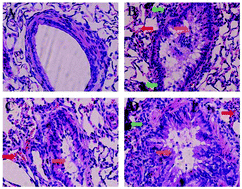当前位置:
X-MOL 学术
›
Toxicol. Res.
›
论文详情
Our official English website, www.x-mol.net, welcomes your
feedback! (Note: you will need to create a separate account there.)
Effects of ambient PM2.5 and 9-nitroanthracene on DNA damage and repair, oxidative stress and metabolic enzymes in the lungs of rats
Toxicology Research ( IF 2.2 ) Pub Date : 2017-05-18 00:00:00 , DOI: 10.1039/c7tx00065k Ruijin Li 1, 2, 3, 4 , Lifang Zhao 1, 2, 3, 4 , Li Zhang 1, 2, 3, 4 , Minghui Chen 1, 2, 3, 4 , Jing Shi 2, 3, 4, 5 , Chuan Dong 1, 2, 3, 4 , Zongwei Cai 6, 7, 8, 9
Toxicology Research ( IF 2.2 ) Pub Date : 2017-05-18 00:00:00 , DOI: 10.1039/c7tx00065k Ruijin Li 1, 2, 3, 4 , Lifang Zhao 1, 2, 3, 4 , Li Zhang 1, 2, 3, 4 , Minghui Chen 1, 2, 3, 4 , Jing Shi 2, 3, 4, 5 , Chuan Dong 1, 2, 3, 4 , Zongwei Cai 6, 7, 8, 9
Affiliation

|
Ambient fine particulate matter (PM2.5) is a complex mixture associated with lung cancer risk. PM2.5-bound nitro-polycyclic aromatic hydrocarbons (NPAHs) have been demonstrated to possess mutagenicity and carcinogenicity. Previous studies showed that PM2.5 induced DNA damage, whereas there is little knowledge of whether 9-nitroanthracene (9-NA), a typical compound of NPAHs in PM2.5, causes DNA damage. Also, the regulating mechanisms of PM2.5 and 9-NA in DNA damage and repair are not yet fully established. Here we sought to investigate the molecular mechanisms of DNA damage and repair in the lungs of male Wistar rats exposed to PM2.5 (1.5 mg per kg body weight) or three different dosages of 9-NA. And then DNA strand breaks, 8-OH-dG formation, DNA–protein crosslink and DNA repair gene expressions in rat lungs were analyzed. In addition, alteration in oxidative stress factors and metabolic enzymes were detected. The results showed that (1) PM2.5 and higher dosage 9-NA (4.0 × 10−5 and 1.2 × 10−4 mg per kg body weight) significantly caused lung DNA damage, accompanied by increasing OGG1 expression while inhibiting MTH1 and XRCC1 expression, elevating the levels of GADD153, hemeoxygenase-1 and malondialdehyde, and promoting the activities of CYP450 isozymes and glutathione S-transferase. (2) 1.3 × 10−5 mg kg−1 9-NA exposure couldn't cause DNA damage and oxidative stress. (3) At the approximately equivalent dose level, PM2.5-induced DNA damage effects were more obvious than 9-NA with positive correlation. It suggests that DNA damage caused by PM2.5 and 9-NA may be mediated partially through influencing the DNA repair capacity and enhancing oxidative stress and biotransformation, and this negative effect of 9-NA might be related to the PM2.5-induced lung genotoxicity.
中文翻译:

PM 2.5和9-硝基蒽对大鼠肺部DNA损伤和修复,氧化应激和代谢酶的影响
环境细颗粒物(PM 2.5)是与肺癌风险相关的复杂混合物。已证明PM 2.5结合的硝基多环芳烃(NPAH)具有诱变性和致癌性。先前的研究表明,PM 2.5会引起DNA损伤,而对PM 2.5中典型的NPAHs化合物9-硝基蒽(9-NA)是否会引起DNA损伤知之甚少。而且,PM 2.5和9-NA在DNA损伤和修复中的调控机制尚未完全建立。在这里,我们试图研究暴露于PM 2.5的雄性Wistar大鼠肺中DNA损伤和修复的分子机制。(每公斤体重1.5毫克)或三种不同剂量的9-NA。然后分析了大鼠肺中的DNA链断裂,8-OH-dG形成,DNA-蛋白质交联和DNA修复基因表达。另外,检测到氧化应激因子和代谢酶的改变。结果表明:(1)PM 2.5和更高剂量的9-NA(每公斤体重4.0×10 -5和1.2×10 -4 mg)显着引起肺DNA损伤,并伴随OGG1表达增加而抑制MTH1和XRCC1表达,可提高GADD153,血红素加氧酶1和丙二醛的水平,并促进CYP450同工酶和谷胱甘肽S-转移酶的活性。(2)1.3×10 -5毫克公斤-19-NA暴露不会引起DNA损伤和氧化应激。(3)在近似相等的剂量水平,PM 2.5诱导的DNA损伤作用比9-NA更明显,且呈正相关。这表明由PM 2.5和9-NA引起的DNA损伤可能是通过影响DNA修复能力,增强氧化应激和生物转化而部分介导的,而9-NA的这种负面影响可能与PM 2.5诱导的肺部遗传毒性有关。
更新日期:2017-05-18
中文翻译:

PM 2.5和9-硝基蒽对大鼠肺部DNA损伤和修复,氧化应激和代谢酶的影响
环境细颗粒物(PM 2.5)是与肺癌风险相关的复杂混合物。已证明PM 2.5结合的硝基多环芳烃(NPAH)具有诱变性和致癌性。先前的研究表明,PM 2.5会引起DNA损伤,而对PM 2.5中典型的NPAHs化合物9-硝基蒽(9-NA)是否会引起DNA损伤知之甚少。而且,PM 2.5和9-NA在DNA损伤和修复中的调控机制尚未完全建立。在这里,我们试图研究暴露于PM 2.5的雄性Wistar大鼠肺中DNA损伤和修复的分子机制。(每公斤体重1.5毫克)或三种不同剂量的9-NA。然后分析了大鼠肺中的DNA链断裂,8-OH-dG形成,DNA-蛋白质交联和DNA修复基因表达。另外,检测到氧化应激因子和代谢酶的改变。结果表明:(1)PM 2.5和更高剂量的9-NA(每公斤体重4.0×10 -5和1.2×10 -4 mg)显着引起肺DNA损伤,并伴随OGG1表达增加而抑制MTH1和XRCC1表达,可提高GADD153,血红素加氧酶1和丙二醛的水平,并促进CYP450同工酶和谷胱甘肽S-转移酶的活性。(2)1.3×10 -5毫克公斤-19-NA暴露不会引起DNA损伤和氧化应激。(3)在近似相等的剂量水平,PM 2.5诱导的DNA损伤作用比9-NA更明显,且呈正相关。这表明由PM 2.5和9-NA引起的DNA损伤可能是通过影响DNA修复能力,增强氧化应激和生物转化而部分介导的,而9-NA的这种负面影响可能与PM 2.5诱导的肺部遗传毒性有关。











































 京公网安备 11010802027423号
京公网安备 11010802027423号